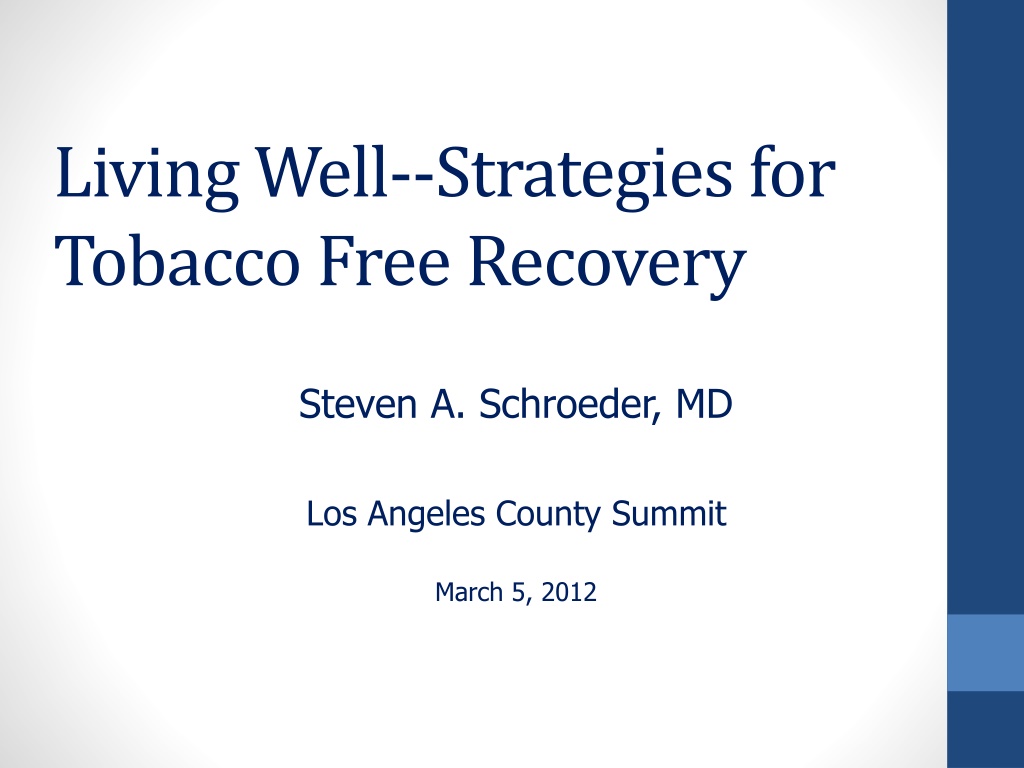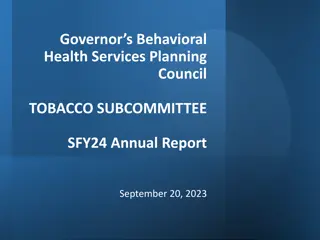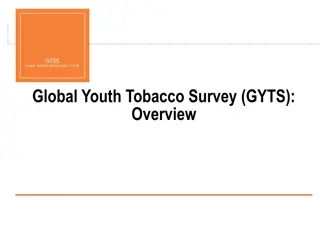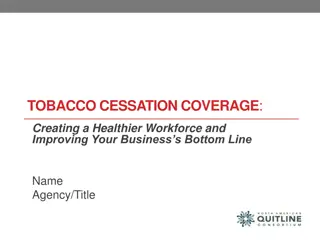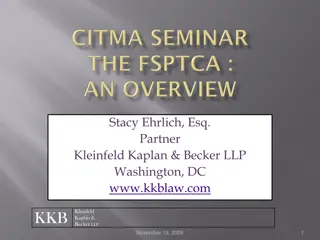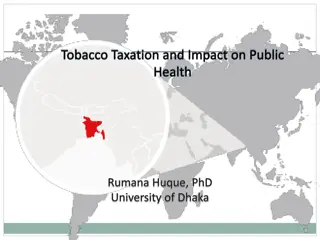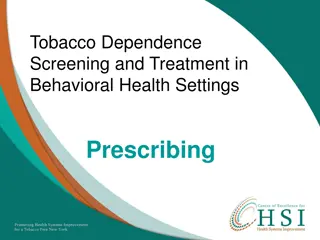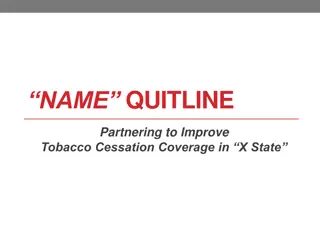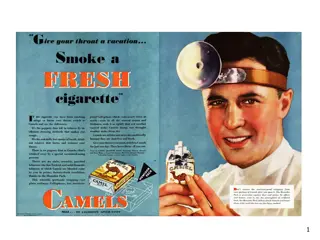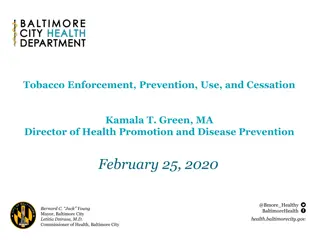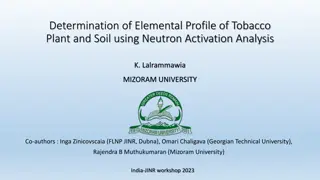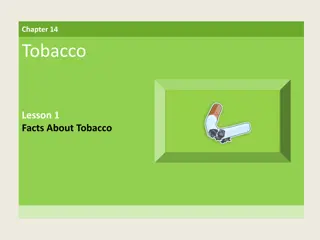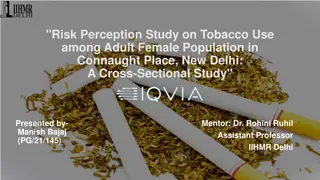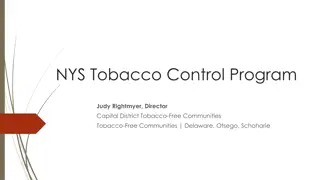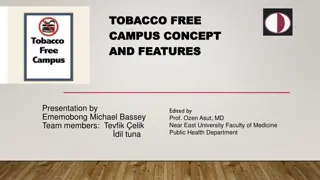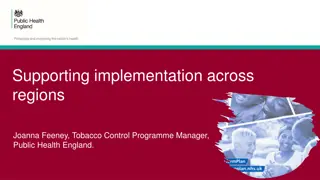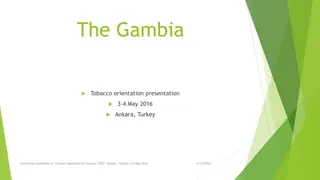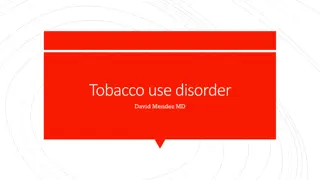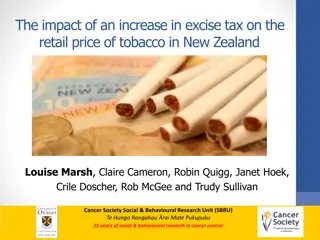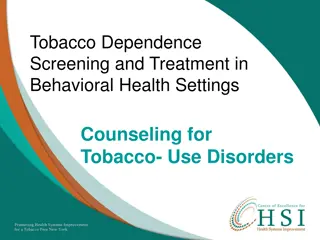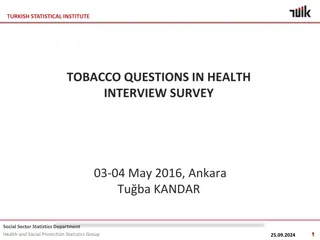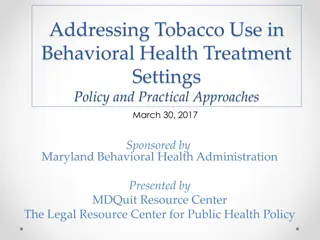Tobacco Use and Behavioral Health: Insights and Implications
High smoking prevalence among individuals with chronic mental illness and substance abuse poses significant health risks, leading to early mortality. The burden extends to addiction treatment center staff, with smoking rates higher than the general population. Data shows a concerning trend in smoking prevalence and its impact on medication efficacy. Efforts to address smoking in behavioral health settings are crucial for promoting overall wellness and reducing preventable deaths.
Download Presentation

Please find below an Image/Link to download the presentation.
The content on the website is provided AS IS for your information and personal use only. It may not be sold, licensed, or shared on other websites without obtaining consent from the author. Download presentation by click this link. If you encounter any issues during the download, it is possible that the publisher has removed the file from their server.
E N D
Presentation Transcript
Living Well--Strategies for Tobacco Free Recovery Steven A. Schroeder, MD Los Angeles County Summit March 5, 2012
Smoking and Behavioral Health: The Heavy Burden 200,000 annual deaths from smoking occur among patients with CMI and/or substance abuse This population consumes 44% of all cigarettes sold in the US -- higher prevalence -- smoke more -- more likely to smoke down to the butt People with CMI die on average 25 years earlier than others, and smoking is a large contributor to that early mortality Smoking in addiction treatment centers ranges 53-91% (Guydish et al, Nicotine and Tobacco Research, June 2011, p. 401)
BH Staff Smoking Rates Smoking prevalence among substance abuse counselors* Ranged from 14%-40% Lowest staff smoking rates (14%) included staff with higher educational and professional training Rates of smoking among treatment staff in MH and SA facilities higher than general population, approximately 30- 40% vs. 22% (Source: Bernstein & Stoduto 1999: Bobo & Hoffman 1995: Bobo & Davis 1993: Bobo & Gilchrist 1983: Williams et al in press) *based on estimates reported in 11 papers
Smoking Prevalence and Average Number of Cigarettes Smoked per Day per Current Smoker 1965-2010 Percent/Number of Cigarettes Smoked Daily Source: Centers for Disease Control and Prevention (1965-2010). NHIS
National Research Institute Research arm of National State Psychiatric Mental Health Program Directors 79 % state operated psychiatric facilities smoke- free up from 20% in 2005, 41 % in 2007 Survey highlights include: 80% offer NRT, up from 60% in 2005 35% of hospitals that allow smoking plan policy changes in the next 2 years
Medications Affected by Smoking Brand Name Elavil Anafranil Aventyl/Pamelor Tofranil Luvox Thorazine Prolixin Haldol Clorizaril Zyprexa Tylenol Inderal Slo-bid, Slo-Phyllin, Theo-24, Theo-Dur, Theobid, Theovent Generic Name Amitriptyline Clomipramine Nortiptyline Imipramine Fluvoxamine Chlorpromazine Fluphenazine Haloperidol Clozapine Olanzapine Acetaminophen Propanolol Theophylline Caffeine
Mental Health Key Messages 25 year mortality gap due largely to smoking Smokers with schizophrenia spend >1/4 income on cigarettes Tobacco use interferes with psychiatric medications Although more than 2/3 of smokers want to quit only 3% able to quit on their own-need help Highly addicted smokers with mental illness can quit and more likely to succeed with medications and behavioral therapy
Tobacco and Addiction Treatment Co-founders of AA, Dr. Bob and Bill W., died of tobacco related diseases Most states exempt addiction treatment settings when regulating smoking in the workplace Unintended consequences of SA Treatment: Usually if a person has not started smoking by age 20, it s unlikely that they will ever smoke. But a significant number of adult substance abusers start smoking in treatment (Friend & Pagano, 2004)
Key Messages in SA High association between smoking, illicit drug use, and alcohol use Tobacco is a gateway drug Nearly 50% of people in recovery will die from tobacco-related diseases (Hughes et al, 2000; Hurt et al., 1996)
Nicotine a Gateway Drug Kandel showed nicotine addiction can cause cocaine addiction in rats, but not vice versa Implications are 2-fold: 1. Nicotine a gateway drug for cocaine; exposure to it enhances subsequent pleasure from cocaine 2. Thus, giving NRT to cocaine users may exacerbate cocaine dependency Source: A. Levine, Y. Huang, B. Drisaldi, E. A. Griffin, D. D. Pollak, S. Xu, D. Yin, C. Schaffran, D. B. Kandel, E. R. Kandel. Molecular Mechanism for a Gateway Drug: Epigenetic Changes Initiated by Nicotine Prime Gene Expression by Cocaine. Science Translational Medicine, 2011; 3 (107)
Nicotine and other Addictions Nationally 77-93% of people in addiction treatment settings use tobacco, more than triple the national average Source: Richter et al., 2001 Tobacco use may increase the pleasure experienced when drinking alcohol Source: US DHHS NIDA Alcohol Alert, 2007 Heavy smoking may contribute to increased use of cocaine and heroin Source: US DHHS NIDA Notes, 2000 Heavy smokers have other, more severe addictions than non- smokers and moderate smokers Source: Marks et al., 1997; Krejci, Steinberg, and Ziedonis; 2003 11
SAMHSAs New (Dec 2011) Definition of Recovery "A process of change through which individuals improve their health and wellness, live a self-directed life, and strive to reach their full potential." Improve their health and wellness = Life Live a self-directed life = Liberty Strive to reach their full potential = Pursuit of happiness
SCLC, Smoking, and Behavioral Health SCLC created in 2003 at UCSF Initial grant from RWJF Subsequent funding from --American Legacy Foundation, specifically for behavioral health work --The VA --CPPW through LA County Project TRUST Other support --SAMHSA --CADCA
CADCA Community Anti-Drug Coalitions of America 5000 community coalitions nationwide Grass roots advocacy Smoking 3rd highest priority according to 2011 annual member survey Never before addressed tobacco Now funded by a CDC Community Transformation Grant, plus RWJF grant
Other SCLC Behavioral Health Partners American Psychiatric Nurses Association National Association of State Alcohol and Drug Abuse Directors Faces and Voices of Recovery National Council for Community Behavioral Health The Association for Addiction Professionals Depression Bipolar Support Alliance Behavioral Health Advisory Forum (education of QL staff)
SCLC Publications in BH Depression, Smoking, and Heart Disease: How Can Psychiatrists Be Effective? Schroeder SA. Editorial. American Journal of Psychiatry. 168:876-878, September 2011 Tobacco use in those with mental health and substance abuse problems: Neglected epidemic. Schroeder SA, Morris C. Annual Review of Public Health, 2010 31:16.1-16.18 Clinical Crossroads: A 51-year-old woman with bipolar disorder who wants to quit smoking. Schroeder SA. JAMA 301: 522-31, 2009. Stranded in the Periphery The Increasing Marginalization of Smokers. Schroeder SA. N Engl J Med 2008;358:21. Varenicline: A Designer Drug to Help Smokers Quit. Schroeder SA, Sox HC. Annals of Internal Medicine. 2006. What to do with a patient who smokes. Schroeder SA. JAMA, July 27, 2005 Vol 294, No. 4.
Common Elements of BH Partnerships Work with peers Policy change Motivate clinicians Culture change from tolerance to cessation Identify and celebrate champions Overcome hesitancy to promote quitlines Penetrate the professional literature Greater visibility at conferences, in newsletters, etc. Multiple educational vehicles (webinars, toolkits, Communiqu s, articles, listserv)
Tobacco Tipping Point? NRI Survey 79% state operated psychiatric facilities smoke-free California 11.9% adult smoking prevalence in 2010 Smokers smoke fewer cigarettes Northern California Kaiser Permanente at 9% Proliferation of smoke-free areas New FDA warning photos on cigarette packs, if withstand court challenge
